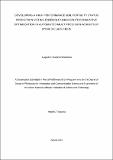| dc.description.abstract | With the advent of machine learning (ML) techniques, various algorithms have been applied in
previous studies to develop models for predicting soil fertility status. However, these models are
observed to use varying fertility target classes, and variations have been reported in these models'
predictive performances. As a result, practical applications of these models for obtaining the most
accurate predictions may become hindered. While the weighted voting ensemble (WVE) ML
technique can be used to improve soil fertility status prediction by aggregating individual models
prediction, guaranteeing finding of an optimal WVE assignment weights is challenging. Whereas
a brute exhaustive search procedure can be applied for the mentioned task, there is a lack of
exploration on the exploitation of automated classifiers' precise weights combinations as search
spaces for successful optimization. This research aims to develop a high-performance soil
fertility status prediction voting ensemble using brute exhaustive optimization in automated
1EXP(-)Z+ multi-precision weights of hybrid classifiers. Soil chemical properties and ML
modeling algorithms for modeling soil fertility status were identified. Base hybrid ML
classification models for predicting soil fertility status were evaluated using Tanzania as a case
study. Finally, the base ML hybrids WVE models were optimized using brute exhaustive search
procedure’s novel developed search spaces generation algorithm for guaranteed optimal solution
finding. The research was designed using design science research methodology, with the
application of unsupervised machine learning K-mean algorithm with a knee detection method
to find the optimal number of soil fertility status target classes, and supervised learning
algorithms were applied to model classifiers for those optimal classes. Three soil fertility target
classes were identified by clustering technique. The model achieved on test data a predictive
accuracy of 98.93%, with respective AUC of 82%, 83%, and 87% for low, medium, and high
soil fertility targets classes. Whereas these performances are observed higher compared to models
in previous studies, 92% correct classifications were obtained on validation against external
unseen laboratory-based tested soil results. Therefore, soil testing laboratories and farmers should
consider using the model to smartly manage soil fertility which may lead to improved crop
growth and productivity. The government could set agricultural-related policies that require the
use of the model by farmers with the provision of agricultural inputs subsidies. Future work could
be to develop an integrated real-time web and mobile application for providing farmers with soil
fertility status information. | en_US |

